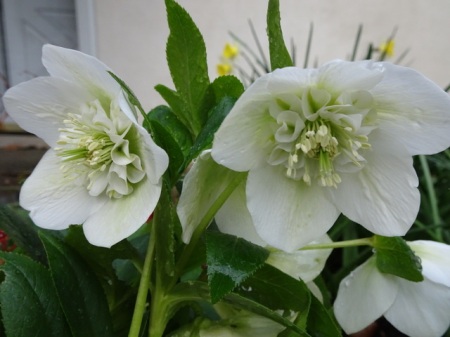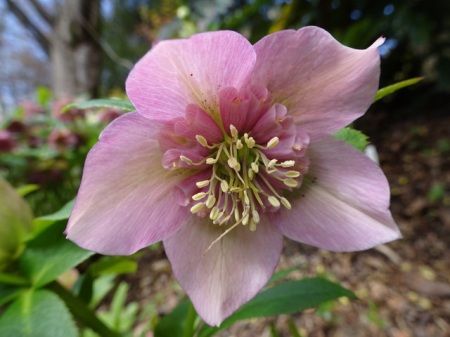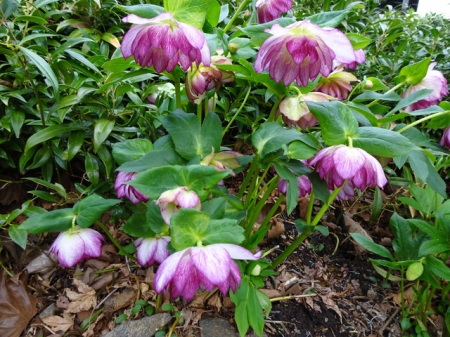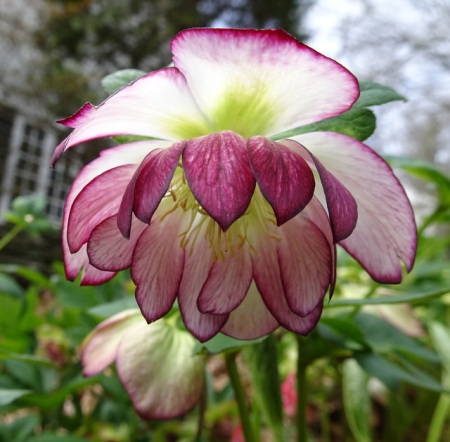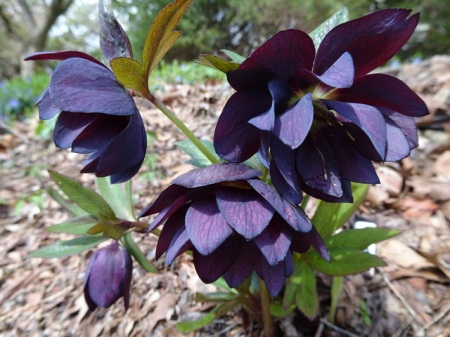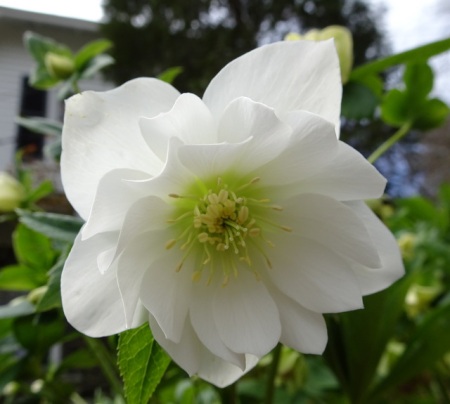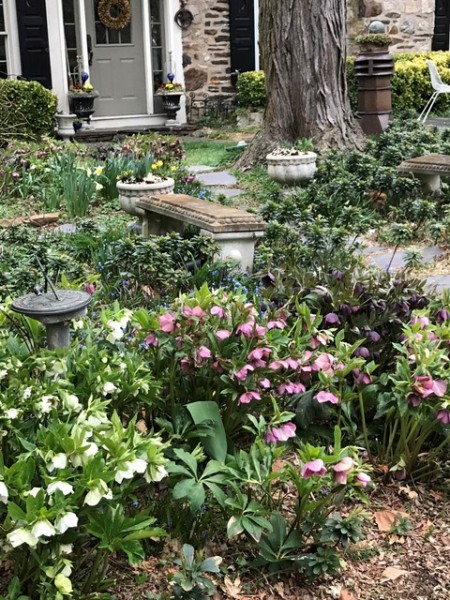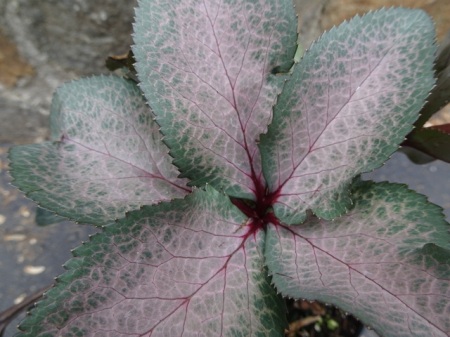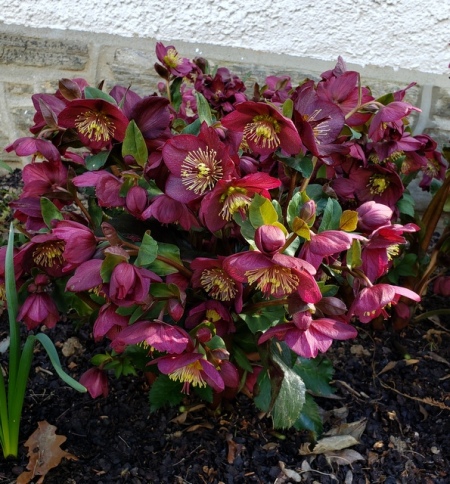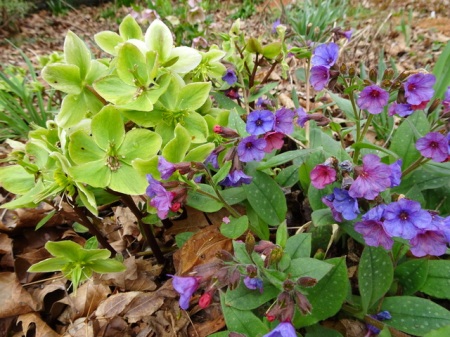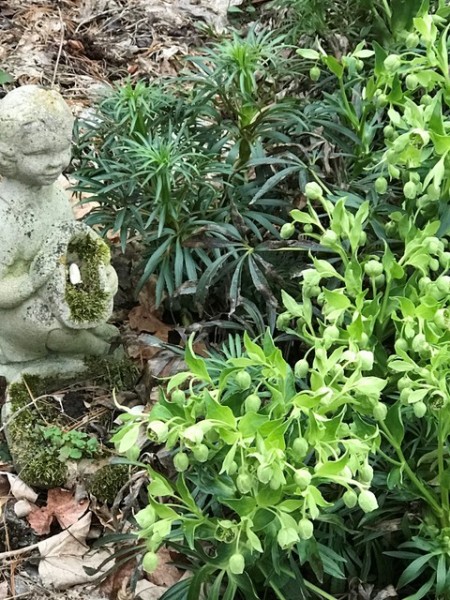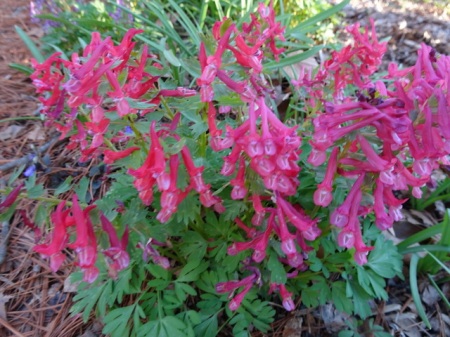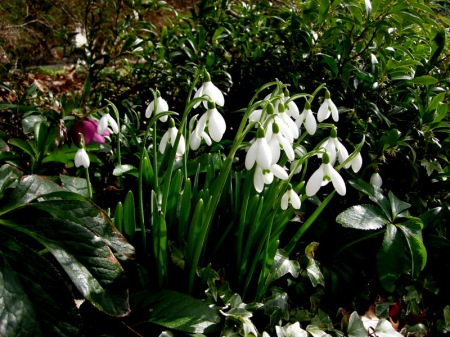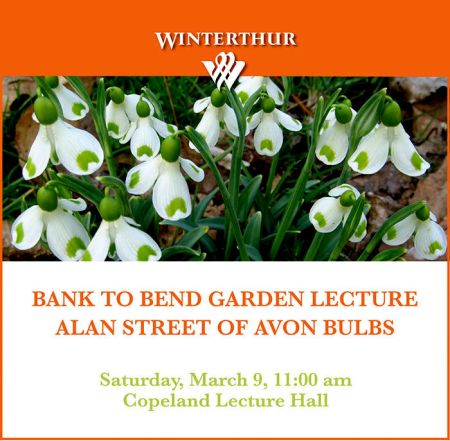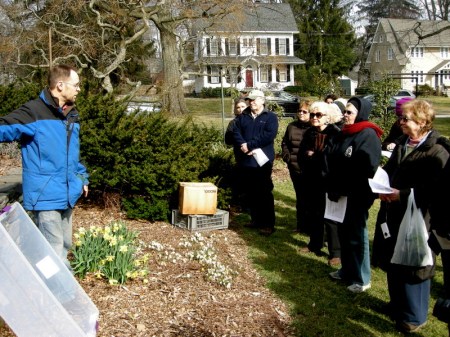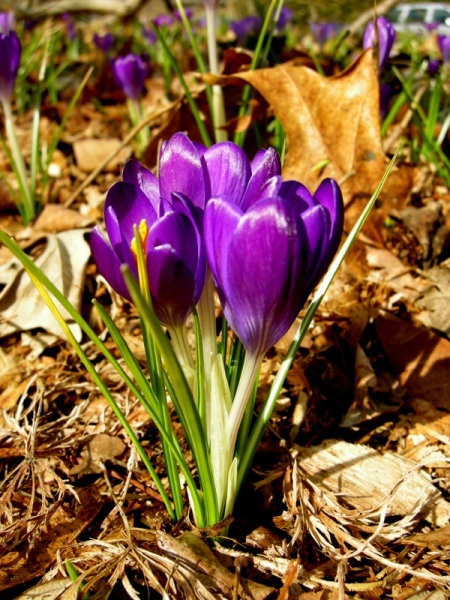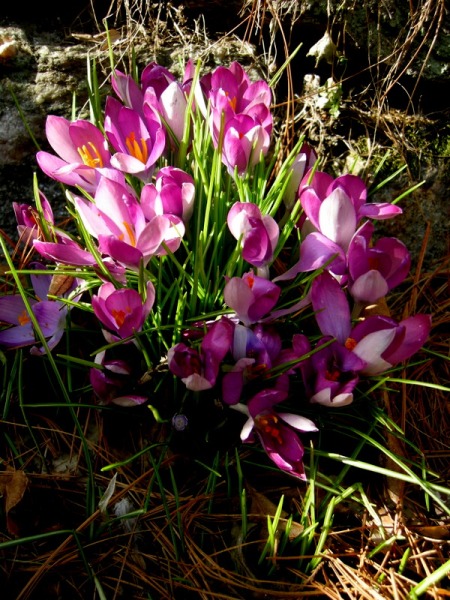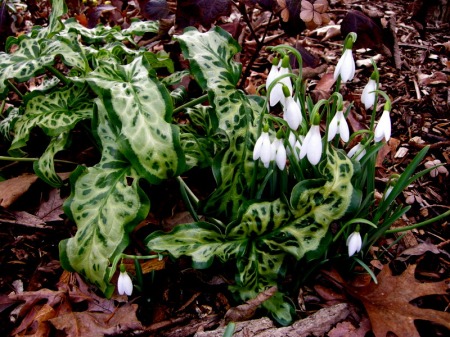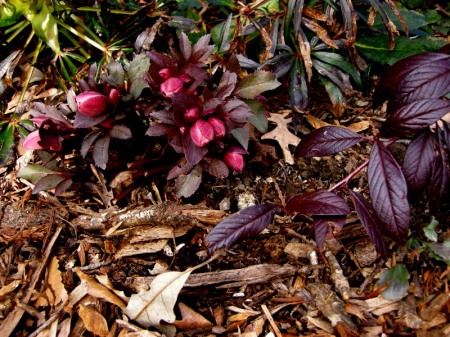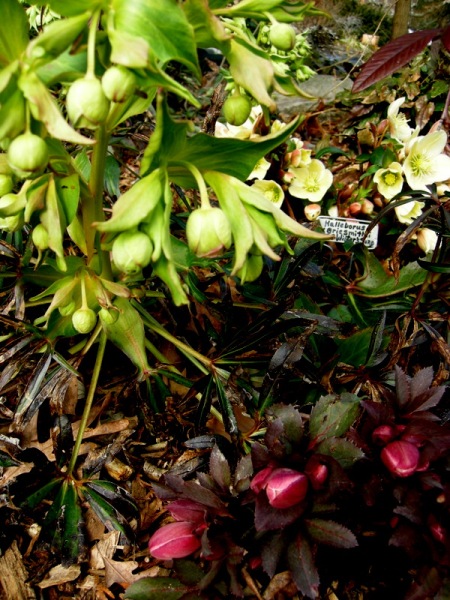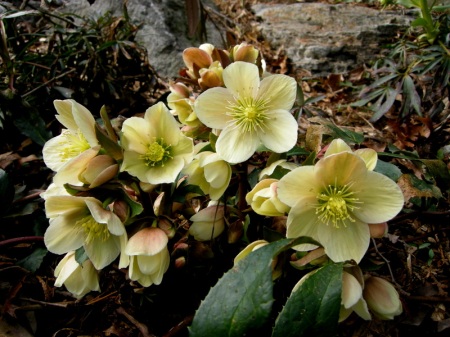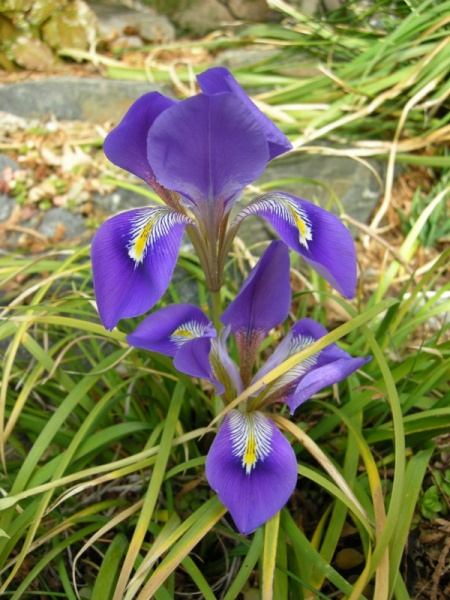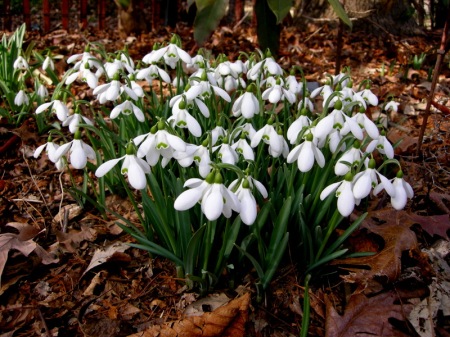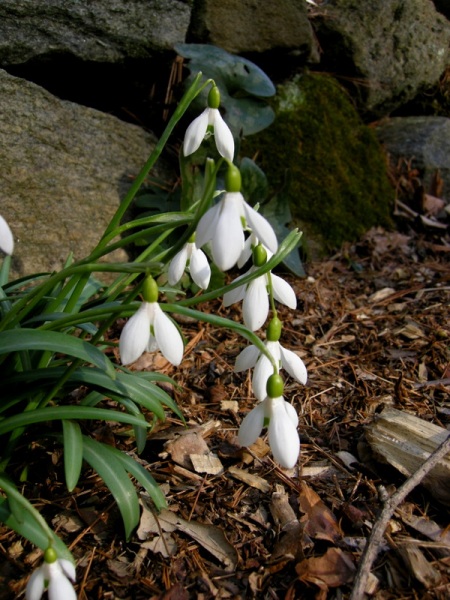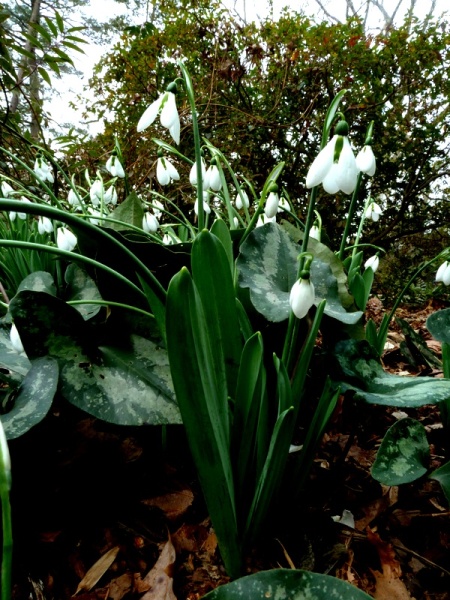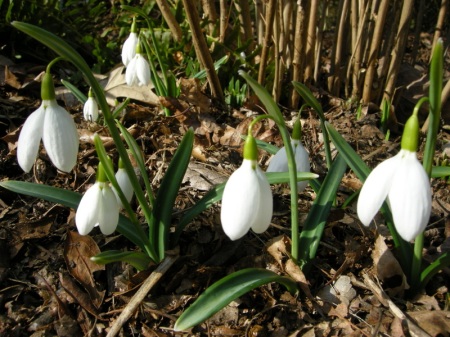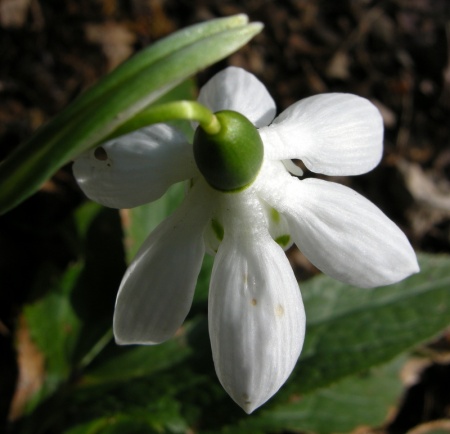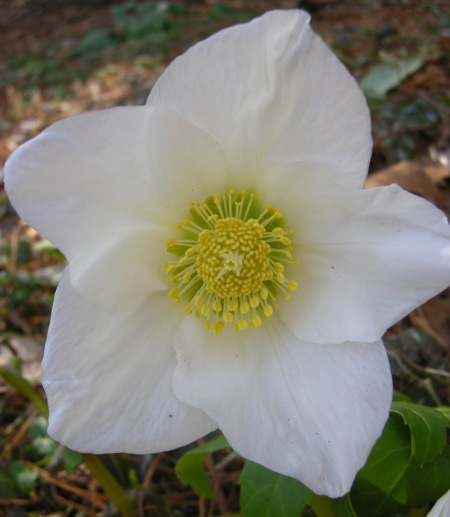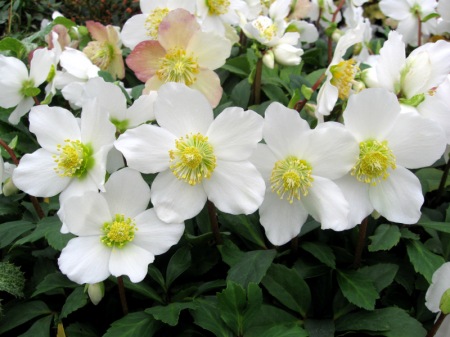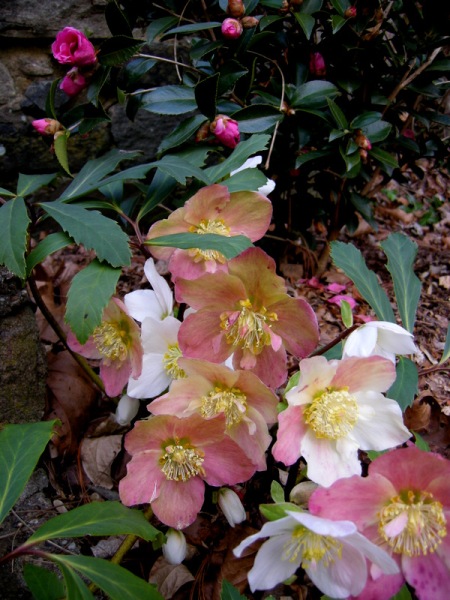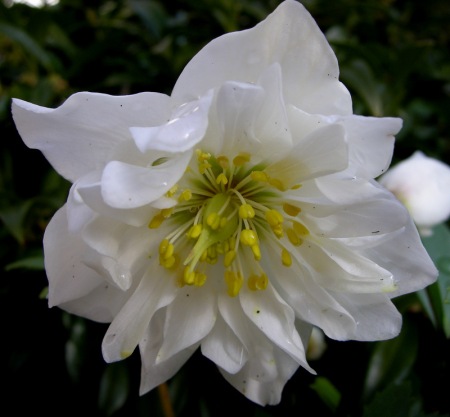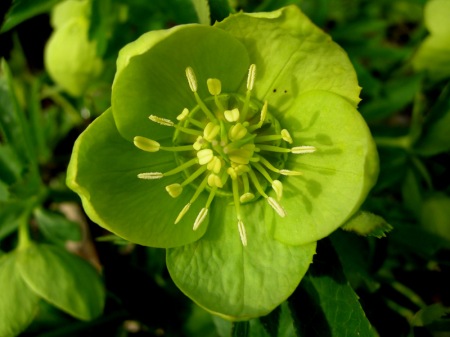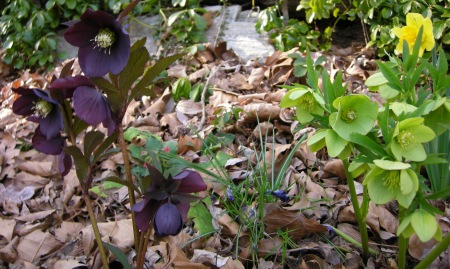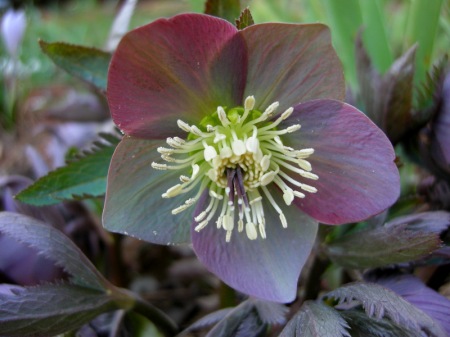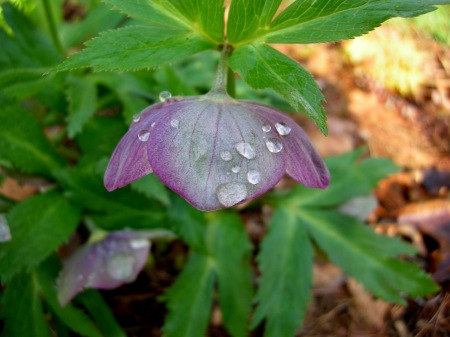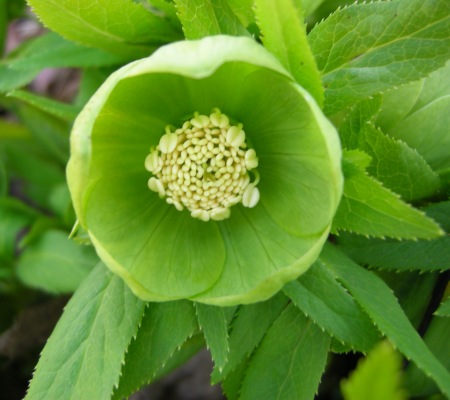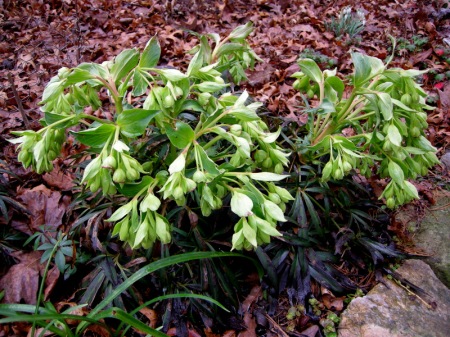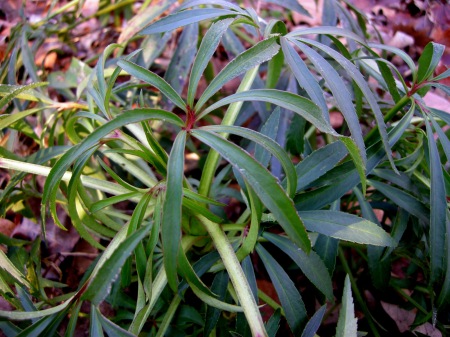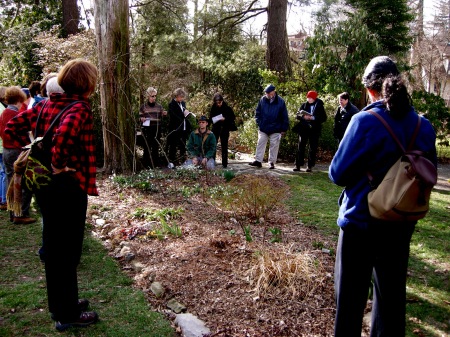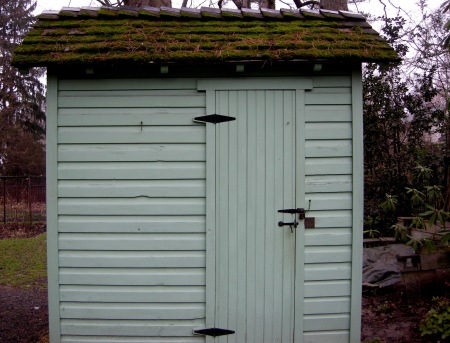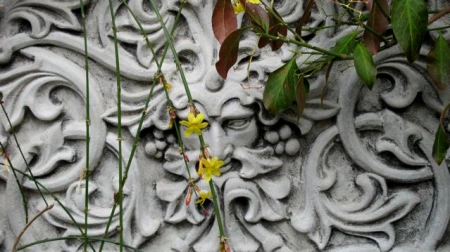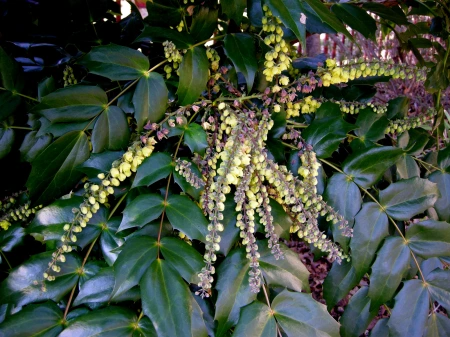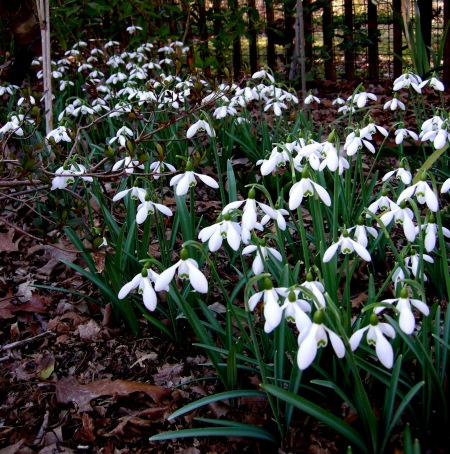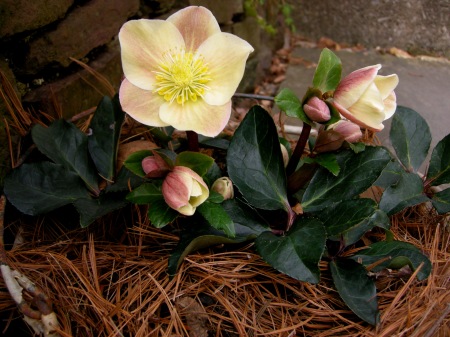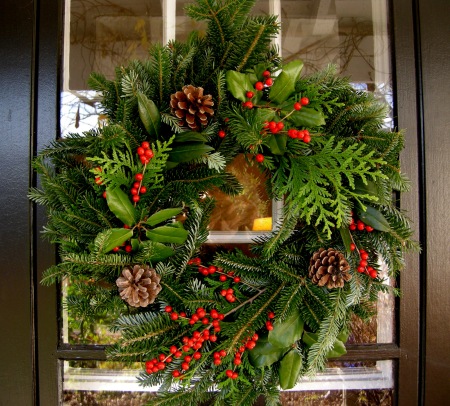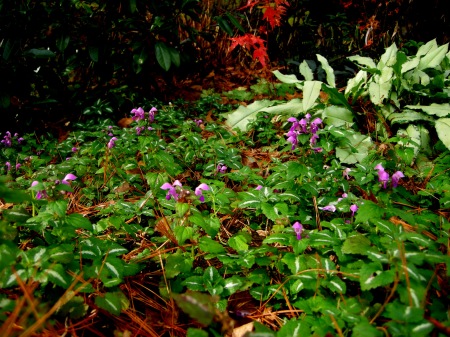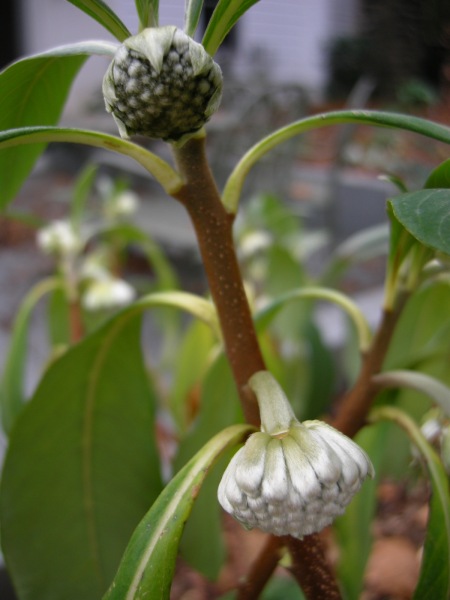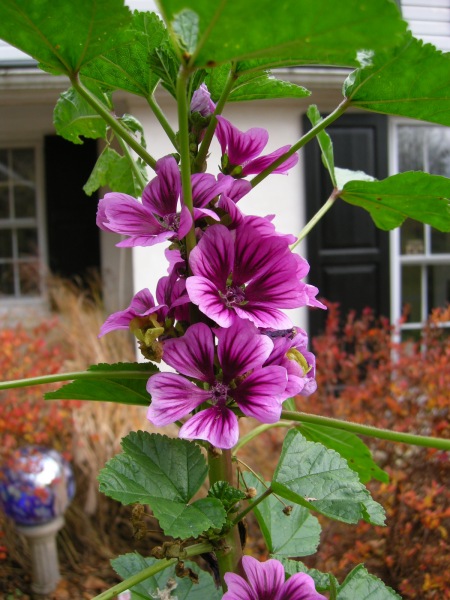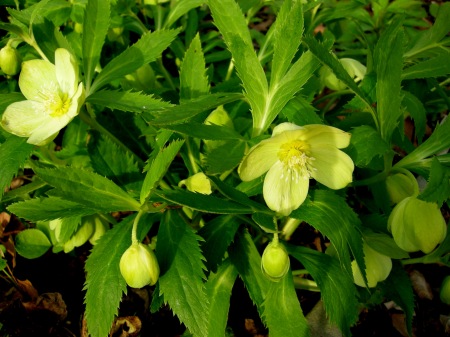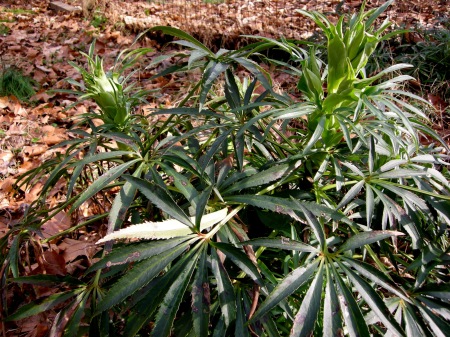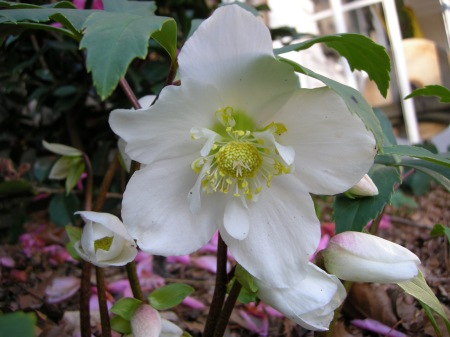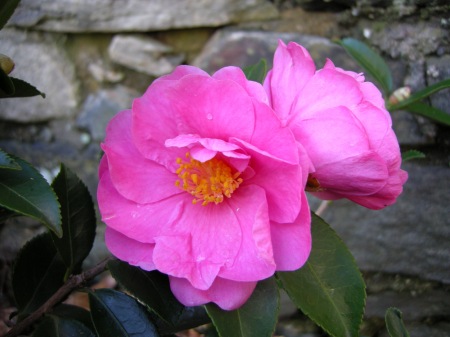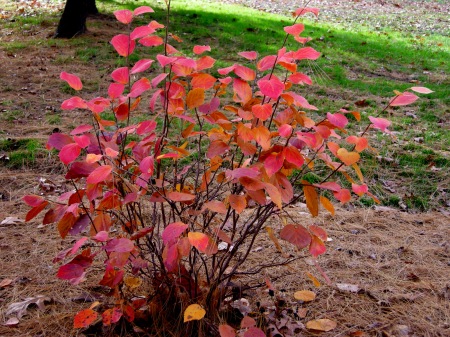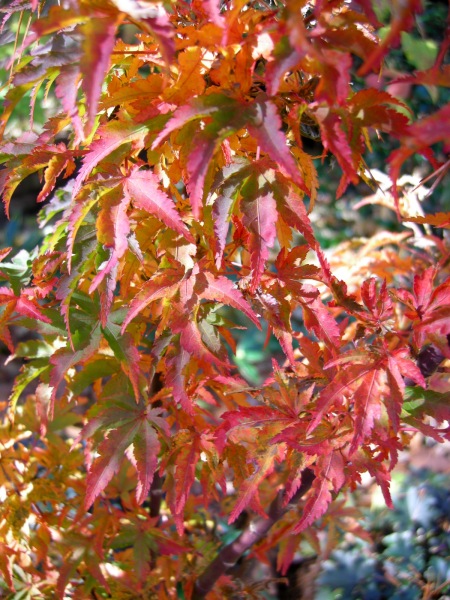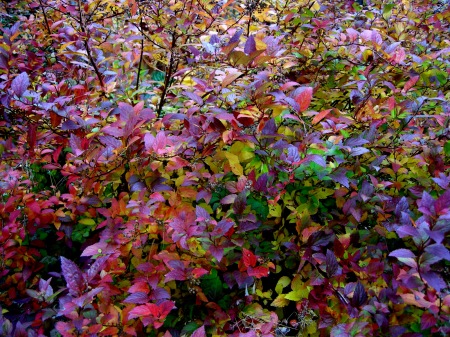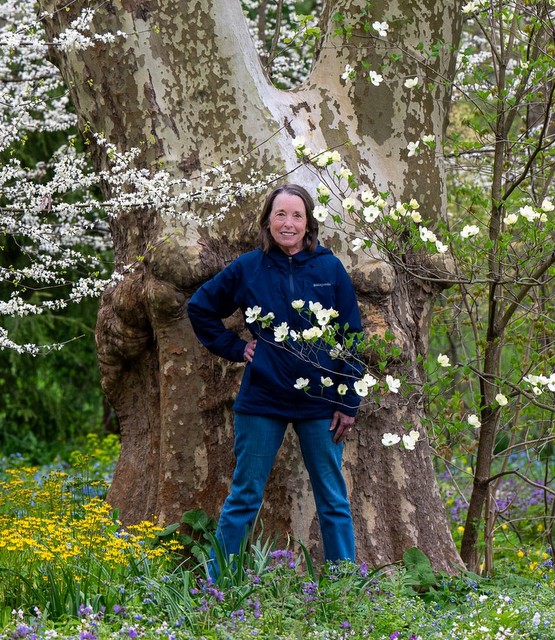Carolyn’s Shade Gardens is a retail nursery located in Bryn Mawr, PA, specializing in showy, colorful, and unusual plants for shade. The only plants that we ship are snowdrops within the US. For catalogues and announcements of local events, please send your full name, mailing address, and cell number to carolyn@carolynsshadegardens.com and indicate whether you are interested in snowdrops, hellebores, and/or hostas. Click here to get to the home page of our website for catalogues and information about our nursery and to subscribe to our blog.
 ‘Jacob’ Christmas rose, Helleborus niger ‘Jacob’, right now in my garden. It always starts blooming in the fall, see Hellebores for Fall. Photo 1/1/12
‘Jacob’ Christmas rose, Helleborus niger ‘Jacob’, right now in my garden. It always starts blooming in the fall, see Hellebores for Fall. Photo 1/1/12
I usually don’t think about cutting back my hellebores until mid-February when the flower stalks begin to extend up through the old leaves. However, here in southeastern Pennsylvania, we have had unusually mild weather during December—10 days over 50 degrees (10 C) and 8 days at 60 degrees (16C). Hellebores that don’t usually bloom until February are coming into bloom now. It seems like a good time to explain the ins and outs of cutting back the old leaves on hellebores. This is done for aesthetic reasons and is not necessary for the health of the plant.
 This beautiful hybrid hellebore, H. x hybridus ‘Pink Tea Cup’, is fully out right now. It usually blooms in February. Photo 12/31/11
This beautiful hybrid hellebore, H. x hybridus ‘Pink Tea Cup’, is fully out right now. It usually blooms in February. Photo 12/31/11
The genus Helleborus contains about 15 species, and decisions about how to care for them require some knowledge of exactly which hellebores you have and how they grow. The most commonly available hellebores are hybrid hellebores, Helleborus x hybridus (the Royal Horticultural Society approved name, previously called Lenten rose), with the large, showy, nodding flowers in an amazing range of colors. For some beautiful photos, check out my articles An Ode to Seed Strain Hellebores and Double Hellebores. Christmas rose, Helleborus niger, is also regularly found in gardens: for photos see Christmas Rose: The Perfect Hellebore. Both hybrid hellebores and Christmas roses produce leaves and flowers on separate stems (botanists call them acaulescent) so cutting back the leaves has no affect on the flowers. The questions is when to cut.
 If there is a “common” hellebore, then the un-named hybrid hellebore above would be it. I couldn’t even begin to count the number of flowers on this one plant. No leaves are visible yet, what you are seeing are bracts on the flower stems. Photo 3/21/11
If there is a “common” hellebore, then the un-named hybrid hellebore above would be it. I couldn’t even begin to count the number of flowers on this one plant. No leaves are visible yet, what you are seeing are bracts on the flower stems. Photo 3/21/11
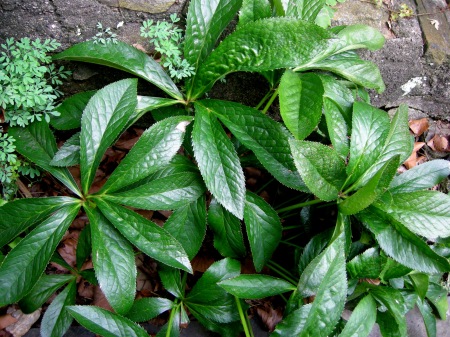 I do not cut back the leaves of hybrid hellebores in the fall because they are very pretty through the winter.
I do not cut back the leaves of hybrid hellebores in the fall because they are very pretty through the winter.
Hybrid hellebores have attractive leaves that stay green all winter (wintergreen), adding interest to the winter garden, so I leave them on as long as they look nice. They are not evergreen though so the old leaves should be cut off when they become unsightly in late winter. It is easiest to do this when the flower buds are still at the soil level and the old leaf stems and new flower stems are not yet intermingled.
 This photograph illustrates the new flower stems emerging among the old leaf stems, which will be cut off February 15. Usually the leaves are standing up causing old and new to mingle, but also providing some protection from cold weather. Photo 12/31/11
This photograph illustrates the new flower stems emerging among the old leaf stems, which will be cut off February 15. Usually the leaves are standing up causing old and new to mingle, but also providing some protection from cold weather. Photo 12/31/11
In addition to winter interest, I also leave the old leaves on to protect the flower buds should we experience very cold weather in January and early February. For southeastern Pennsylvania, this could be as low as -5 degrees (-21C). I cut back my hybrid hellebores around February 15. The same rules apply for the nine species hellebores that are the parents of hybrid hellebores (see The Sex Lives of Hellebores) should you have them in your garden.
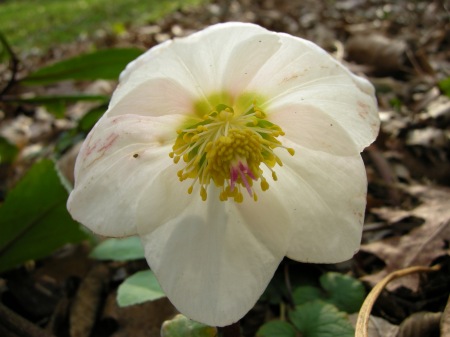 This straight species Christmas rose is blooming right now in my garden—it has never bloomed before March in the almost 15 years I have had it. Notice the lack of leafy bracts on the stem. Photo 12/31/11
This straight species Christmas rose is blooming right now in my garden—it has never bloomed before March in the almost 15 years I have had it. Notice the lack of leafy bracts on the stem. Photo 12/31/11
 Christmas roses have very clean and elegant, blue-green leaves.
Christmas roses have very clean and elegant, blue-green leaves.
Christmas roses have even more beautiful wintergreen leaves. Although you can cut them back without affecting the flowers (they are acaulescent), my considerations for this hellebore are somewhat different. The flower stems of hybrid hellebores contain the buds and also leaf-like bracts, which provide a pleasing green backdrop for the blooming flowers (see photo of pink hybrid above). Christmas rose flower stems have no bracts so if you cut off all the leaves, to me, the plant looks naked when it blooms. As long as the leaves remain halfway decent, I leave them on until later in the season to serve as a frame for the flowers. The leaf and flower stems do not intermingle so cutting them later is not a problem.
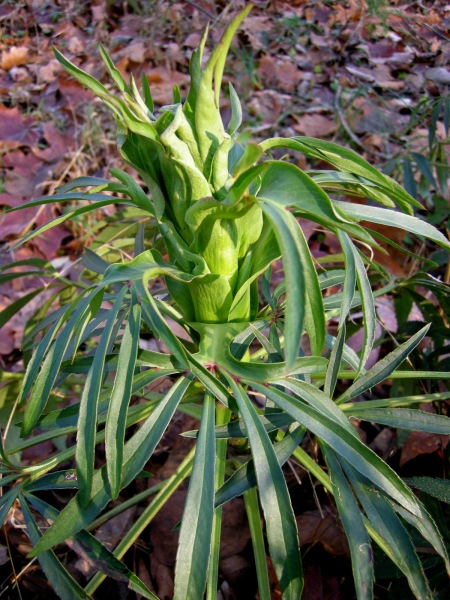 The buds of bearsfoot hellebore, H. foetidus, emerge from the top of the leaf stem in the fall. For more photos of this spectacular hellebore, see Hellebores for Fall. Photo 12/2/10
The buds of bearsfoot hellebore, H. foetidus, emerge from the top of the leaf stem in the fall. For more photos of this spectacular hellebore, see Hellebores for Fall. Photo 12/2/10
There are two more wintergreen hellebore species that make their way into hellebore lovers’ gardens: Corsican hellebore, Helleborus argutifolius, and bearsfoot hellebore, Helleborus foetidus. Botanists call these species caulescent because the flowers are not separate but are on the end of the leaf stem. You cannot cut off the leaf stem until after the plant has flowered because you will be removing the flower buds. And if you cut off the individual leaves, you are left with a long, ugly stalk, typically 2-3′, with the flowers at the tip.
 I grow Corsican hellebore, H. argutifolius, as much for its gorgeous wintergreen leaves as for its flowers.
I grow Corsican hellebore, H. argutifolius, as much for its gorgeous wintergreen leaves as for its flowers.
In mild winters when the leaves remain attractive, this is not a problem. It is also usually not a problem for bearsfoot hellebore whose leaves remain pristine during very cold winters. However, Corsican hellebore leaves are easily damaged, and I often make the decision to sacrifice the flowers and cut the plants back to the ground rather than look at their unsightly leaves while they bloom. I grow this species equally for its foliage, and new growth springs up very quickly when the old stems are removed.
 H. x ericsmithii ‘Winter’s Song’ in my garden right now—much earlier than normal for this species cross. Notice the leafy bracts surrounding the flowers. Photo 12/31/11
H. x ericsmithii ‘Winter’s Song’ in my garden right now—much earlier than normal for this species cross. Notice the leafy bracts surrounding the flowers. Photo 12/31/11
 H. x ballardiae ‘Pink Frost’ displaying the pink color inherited from its parent H. lividus. Photo 3/21/11
H. x ballardiae ‘Pink Frost’ displaying the pink color inherited from its parent H. lividus. Photo 3/21/11
That pretty much covers care and maintenance of the hybrid hellebores and the available species hellebores. However, a large group of gorgeous species crosses are beginning to appear in local gardens (especially if the gardener has been shopping at Carolyn’s Shade Gardens), and I want to let you know how to care for them. These plants are generally the progeny of Christmas rose crossed with Corsican hellebore and/or Helleborus lividus (not hardy here) to produce elegant outward-facing flowers and silver-marbled leaves often with red highlights and stems. The most familiar crosses are H. x ericsmithii (‘Silvermoon’, ‘Winter’s Song’), H. x nigercors (‘Honeyhill Joy’, ‘Green Corsican’), and H. x ballardiae (‘Pink Frost’).
 H. x nigercors ‘Green Corsican’: all the Christmas rose crosses have copious amounts of large, very desirable outward-facing flowers. Photo 3/21/11
H. x nigercors ‘Green Corsican’: all the Christmas rose crosses have copious amounts of large, very desirable outward-facing flowers. Photo 3/21/11
The Christmas rose crosses grow differently than either of the two groups discussed above. Their leaves are one of their best features, and I cut them back only if they are unsightly. They do have leaves and flowers on the same stems so you cannot cut the stems back to the base if cutting is necessary. However, the plants are generally short, 12 to 15″, and produce such an abundance of flowers that cutting off individual leaves from the main stem does not leave an ugly stalk. In addition, the flowers usually have leafy bracts to frame their beauty.
 Our 2010-2011 winter was very hard on hellebore leaves. However, even though I cut almost all the damaged leaves off these H. x ericsmithii ‘Silvermoon’ plants, they still look beautiful. Photo 3/24/11
Our 2010-2011 winter was very hard on hellebore leaves. However, even though I cut almost all the damaged leaves off these H. x ericsmithii ‘Silvermoon’ plants, they still look beautiful. Photo 3/24/11
I hope I have answered all your questions about cutting back hellebores. If not, feel free to seek clarification in a comment. You are probably wondering what I will do this year when the hellebores are blooming early. I have decided that discretion is the better part of valor so no leaves will be removed until mid-February.
Carolyn
If you would like to look at my photos all year round, please consider buying my 2012 calendar, available worldwide. For details, click here. It is 25% off through January 6, 2012, with the code ONEMORETHING at checkout.
This is part of a series of articles on hellebores, one of the specialties of my nursery. Here are links to the other articles:
Part One Hellebores for Fall
Part Two An Ode to Seed Strain Hellebores
Part Three Christmas Rose: The Perfect Hellebore
Part Four Dividing Hybrid Hellebores
Part Five The Sex Lives of Hellebores
Part Six Double Hellebores
Part Seven Cutting Back Hellebores
Notes: Every word that appears in orange on my blog is a link that you can click for more information. If you want to return to my blog’s homepage to access the sidebar information (catalogues, previous articles, etc.) or to subscribe to my blog, just click here.
 Bright colors from bark, leaves, and flowers are everywhere at the Savill Garden on a bleak February 1.
Bright colors from bark, leaves, and flowers are everywhere at the Savill Garden on a bleak February 1. Around every corner at the Savill Garden is a beautiful vista featuring plants grown to provide color in winter, here pollarded golden willow stems.
Around every corner at the Savill Garden is a beautiful vista featuring plants grown to provide color in winter, here pollarded golden willow stems. Giant rhubarb, Gunnera sp., is covered with its own large leaves for winter protection.
Giant rhubarb, Gunnera sp., is covered with its own large leaves for winter protection. The garden features many forms of shrub dogwoods grown for their winter branch color, including bloodtwig dogwood, Cornus sanguinea ‘Anny’s Winter Orange’.
The garden features many forms of shrub dogwoods grown for their winter branch color, including bloodtwig dogwood, Cornus sanguinea ‘Anny’s Winter Orange’. A close up of the trunk of one of the birches in the first photo, showing the incredibly white bark of ‘Silver Shadow’ Himalayan birch paired with the flowers and winter green foliage of Helleborus x sternii “Blackthorn Strain”.
A close up of the trunk of one of the birches in the first photo, showing the incredibly white bark of ‘Silver Shadow’ Himalayan birch paired with the flowers and winter green foliage of Helleborus x sternii “Blackthorn Strain”. Tartarian dogwood, Cornus alba ‘Sibirica’
Tartarian dogwood, Cornus alba ‘Sibirica’ ‘Magic Flame’ bloodtwig dogwood surrounded by the broad purple leaves of bergenia, flowering heath, and a winter-blooming daffodil.
‘Magic Flame’ bloodtwig dogwood surrounded by the broad purple leaves of bergenia, flowering heath, and a winter-blooming daffodil. On the other side of ‘Magic Flame’ are the ornamental canes of ‘Golden Vale’ white-stemmed bramble.
On the other side of ‘Magic Flame’ are the ornamental canes of ‘Golden Vale’ white-stemmed bramble. ‘Phoenix’ snakebark maple, a cross between our native tree and a Chinese relative.
‘Phoenix’ snakebark maple, a cross between our native tree and a Chinese relative. The garden features many different forms of witchhazel, including ‘Diane’ above.
The garden features many different forms of witchhazel, including ‘Diane’ above. Snowdrops are sprinkled around the garden, here with the many bright shades of chartreuse that light up this area.
Snowdrops are sprinkled around the garden, here with the many bright shades of chartreuse that light up this area. A form of Acer tegmentosum, striped maple, called ‘Valley Phantom’.
A form of Acer tegmentosum, striped maple, called ‘Valley Phantom’. Early-blooming hellebores, here Helleborus foetidus, are massed through out the winter garden.
Early-blooming hellebores, here Helleborus foetidus, are massed through out the winter garden. ‘Sauwala White’ Himalayan birch
‘Sauwala White’ Himalayan birch A glimpse out towards the rest of the Savill Garden, which would be worth visiting anytime but is spectacular in winter!
A glimpse out towards the rest of the Savill Garden, which would be worth visiting anytime but is spectacular in winter! Thanks to John Anderson for spending so much time outside with us on a very cold winter day (photo of Carolyn and John).
Thanks to John Anderson for spending so much time outside with us on a very cold winter day (photo of Carolyn and John).

